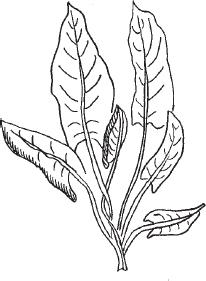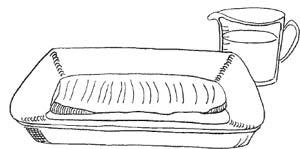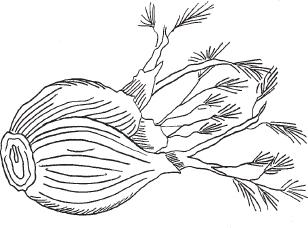Nourishing Traditions: The Cookbook That Challenges Politically Correct Nutrition and The... (78 page)
Authors: Sally Fallon,Pat Connolly,Phd. Mary G. Enig
Tags: #Non-Fiction, #Reference, #Science, #Health

FRIDAY NIGHT DINNER
Salmon with Sun Dried
Flourless Carrot Cake
SALMON WITH SORREL SAUCE
Serves 6
2 pounds filet of wild salmon
4 cups
fish stock1 cup
piima cream
or
creme fraiche1 tablespoon
shrimp butter
, optionalabout 4 packed cups fresh sorrel leaves
3 tablespoons butter
sea salt and pepper
Butter an oblong pyrex dish and set the filet, skin side down, in the dish. Bring the stock to a boil and pour over the filet. If the liquid does not entirely cover the fish, add filtered water. Set in a 325-degree oven and poach until just tender, from 10 to 15 minutes depending on the thickness of the filet. You can check for doneness with a fork. Be careful not to overcook. Remove from the oven when the inside is still a little rare. Set the filet on a heated platter, cover with a piece of parchment paper (See
Sources
) and keep in a heated oven while you prepare the sauce.Meanwhile, wash the sorrel leaves, shake dry and chop coarsely. Saute in butter until completely wilted. Set aside.
Pour poaching stock into a heavy skillet and bring to a rapid boil. Add cream and optional shrimp butter and boil vigorously, until sauce has thickened and reduced to about 1 cup. Stir in the sorrel and season to taste. Divide the filet into six servings and place on individual plates. Spoon a portion of sauce over each and serve immediately.
Dr. Clive McCay. . .found in his longtime experiments at Cornell University that "animals fed very modest amounts of natural foods lived in excellent health until equal in age to people over a hundred years old. They died without getting cancer. Animals fed a high-fuel diet [high in refined fats, starches, sugars and highly refined foods] lived a normal or shortened span of life and had the usual diseases of old age such as cancer." Dean Conrad
The Great American Tragedy

Don't forget that your body needs some high-quality saturated fat in your diet. The antifat craze that has swept America for the past 30 years is responsible for a lot of harm—a lot of misinformation. Here's another example: Researchers with the Department of Agriculture's Human Nutrition Research Center at Tufts University have learned that people who cut back on fat to the tune of eating only fish and vegetables appear to open themselves up to more infection. The lowfat diet, which called for eating fish every day, "significantly reduced the infection fighting power of certain white blood cells." This does not mean you can't eat fish every day if you want to, it means you need to eat some quality fat with it. Tom Valentine
Search for Health

SALMON WITH FENNEL
Serves 6
6 wild salmon steaks
4 cups
fish stock1 fennel bulb, coarsely chopped
½ cup dry white wine
1 tablespoon fennel seeds
1 teaspoon dried green peppercorns
1 cup
piima cream
or
creme fraiche1 tablespoon gelatin (See
Sources
), optional¼ cup butter, softened
18 small sprigs fennel leaves
1 tomato, peeled, seeded and finely chopped
sea salt and pepper
6 teaspoons salmon eggs (optional)
Remove bone and skin from steaks. They will form two pieces. Roll up each piece and tie with string, forming two small "medallions" per person. Set in a buttered pyrex dish, just large enough to hold the medallions, and strew on the chopped fennel. Bring stock to a boil and pour over medallions. Add a little filtered water if stock does not cover the fish. Bake about 8 minutes at 350 degrees or until just cooked. Strain stock into a heavy saucepan, cover medallions with parchment paper (See
Sources
), and keep warm in the oven while you prepare the sauce. (Discard the fennel.)Strain the stock into a heavy skillet, bring to a rapid boil, skim and reduce by half. Add wine, fennel seeds, peppercorns, optional gelatin and cream and reduce to about 1 cup or until sauce has thickened. Strain into a bowl and beat in butter with a whisk, 1 tablespoon at a time. Season to taste. Set bowl in simmering water to keep warm.
Decorate plates with alternating fennel sprigs and spoonfuls of tomato around the outside edge. (To peel tomatoes, see
Kitchen Tips & Hints
.) Remove strings from medallions and set two in the middle of each plate. Spoon sauce over each and decorate with salmon eggs.
For decades we've had dinned in our ears by research foundations and associations that we should follow a lowfat, high-polyunsaturated diet to prevent heart disease.
Then we learned that excess vegetable oils increase the need for vitamin E, bring on premature aging and cause facial skin to wrinkle far before it normally would.
Now the results of research by Gabriel Fernandes, associate professor of medicine in the division of Clinical Immunology at the University of Texas Health Center (San Antonio), point an accusing finger at this dietary change as a probable cause of the near epidemic proportions of malignant melanoma, a deadly skin cancer.
Experiments by Fernandes with mice on calorie-controlled diet with various amounts of polyunsaturated and saturated fats show that heavy emphasis on polyunsaturated fats could indeed be the culprit.
Mice on a diet of 20 percent polyunsaturated fat proved to be far more susceptible to transplanted melanoma and to the spread of it to their lungs than mice on a diet of 20 percent saturated fats. James F. Scheer
Health Freedom News

CREOLE CRAWFISH CASSEROLE
(Etouffee)
Serves 6
24 crawfish tails with shells, fresh or frozen
4 tablespoons olive oil
2 large onions, chopped
2 ripe plum tomatoes, seeded and chopped
1 green pepper, seeded and chopped
4 cloves garlic, peeled and mashed
½ cup butter
½ cup unbleached white flour
1 quart
crawfish stock2-3 tablespoons
shrimp butter½ teaspoon dried thyme
¼ teaspoon cayenne pepper
sea salt
Remove crawfish tails and use the shells to make crawfish stock, reserving crawfish tail meat in the refrigerator.
Saute onion and green pepper in olive oil until soft. Add tomato, raise heat and saute, stirring constantly, until liquid has evaporated. Remove pan from heat and stir in garlic.
Melt butter in a heavy pot. Stir in flour and cook over medium heat, stirring constantly with a wooden spoon, for about 5 minutes or until flour turns light brown. Slowly add crawfish stock, stirring constantly with a whisk. Whisk in shrimp butter and cook over a medium flame, stirring constantly, until sauce thickens. Add sauteed vegetables, cayenne pepper and thyme and season to taste. Add crawfish and simmer over low heat until crawfish are cooked through, stirring frequently. Serve in soup bowls with
basic brown rice
or
coconut rice
.Variation: Creole Shrimp Casserole
Use
about 3 dozen large shrimp
in place of crawfish and
shrimp stock
, in place of crawfish stock.Variation:
Add
1 pound spicy sausage, sliced.
In all of these experiments, immature animals were found to be much more vulnerable to the toxic effects of MSG than were older animals. This was true in all animal species tested.
Yet, food manufacturers continue to add tons of this excitotoxin additive to foods of all kinds, including baby foods. Even the government's public health watchdog agency, the Food and Drug Administration, refused to take action. Dr. Olney, one of the leading researchers in this area, felt compelled to do something to protect unsuspecting mothers and their infants from this danger. First, he informed the FDA of the real danger to human infants and encouraged them to take action. But they refused. His only recourse was to go public with what he knew to be true—that MSG was a dangerous compound that should not be added to infant foods. It was only after his testimony before a Congressional committee that the food manufacturers agreed to remove MSG from baby foods. But did they really?
Instead of adding pure MSG, they added a substance known as hydrolyzed vegetable protein that contains three known excitotoxins and has added MSG. . .this substance is even more dangerous than MSG. They continued this practice for seven more years, and there is evidence that excitotoxins are still added to baby foods today. Usually these are in the form of caseinate, [factory-made] beef or chicken broth, or flavoring. Russell L. Blaylock, MD
Excitotoxins: The Taste That Kills
